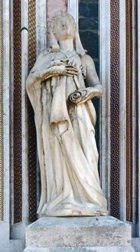Antonio Federighi, who probably came from Siena, was first documented in 1435-8, when he worked on the Duomo there under Jacopo della Quercia. He subsequently served as capomaestro there for three decades (1450-81). He held the same post at Orvieto in 1451-6, an arrangement that must have presented problems for his respective employers.
Orvieto
Duomo
In 1451, “magister Antonius Federici de Senis” was appointed as capomaestro. As noted above, he is documented in this capacity until 1456.
Design of the Facade (1450-6)

Water Stoups (ca. 1456)

Eritrean Sibyl (1456)

Read more:
C. Benocci et al. (Eds), “Storia di Orvieto: Quattrocento e Cinquecento” (2010) Pisa, Volume II contains two particularly relevant articles:
L. Principi, “Fino a Oggi ha Chiamato del Continuo a Ornarla Maestri Forestieri": i Contributi Esterni nella Scultura a Orvieto del Quattrocento e i Riflessi dei Prototipi Orvietani nella Produzione Scultorea del Rinascimento” (pp 536-7); and
L. Principi, “Antonio Federighi a Orvieto : tra l'antico e il Maestro Sottile” (pp 565-84)
Return to Art in Orvieto.
Return to “Foreign” Sculptors in Umbria.



